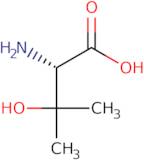Informations sur le produit
- (S)-(+)-2-Amino-3-hydroxy-3-methylbutanoic acid
- (2S)-2-Amino-3-hydroxy-3-methylbutanoic acid
- (S)-3-Hydroxy-2-amino-3-methylbutanoic acid
- 3-Hydroxy-<span class="text-smallcaps">L</span>-valine
- 3-Methyl-<span class="text-smallcaps">L</span>-threonine
- 3-hydroxy-D-valine
- 3-hydroxy-L-valine
- <span class="text-smallcaps">L</span>-Threonine, 3-methyl-
- <span class="text-smallcaps">L</span>-Valine, 3-hydroxy-
- Valine, 3-hydroxy-, <span class="text-smallcaps">L</span>-
- Voir d'autres synonymes
- β-Hydroxy-<span class="text-smallcaps">L</span>-valine
- L-Threonine, 3-methyl-
- L-Valine, 3-hydroxy-
- 3-Methyl-L-threonine
- (S)-(+)-2-Amino-3-Hydroxy-3-Methylbutanoic Acid
- (S)-2-Amino-3-Hydroxy-3-Methylbutanoic Acid
- β-Hydroxy-L-valine
- Valine, 3-hydroxy-, L-
L(+)-Hydroxyvaline is a reactive compound that can be oxidized to produce oxidation products. It has a minimal inhibitory concentration of less than 0.5 μg/ml. L(+)-Hydroxyvaline is a precursor of hydroxybenzoic acid, which is used in the production of griseoluteic acid and aromatic residues. The hydroxy group and hydroxyl group in L(+)-hydroxyvaline are important for its biochemical functions as well as its cellular effects, such as oxygenation and animal metabolism. This compound also has an acidic hydrolysis reaction with organic acids to form choline and glycolic acid.





